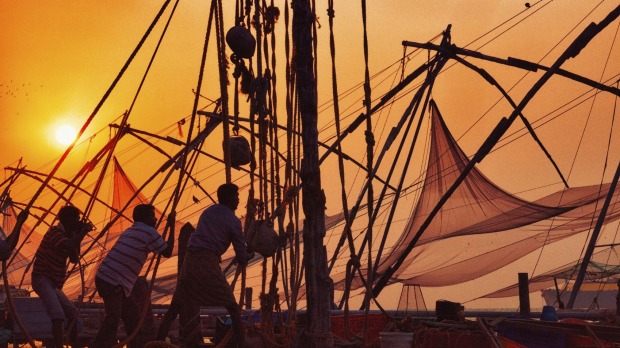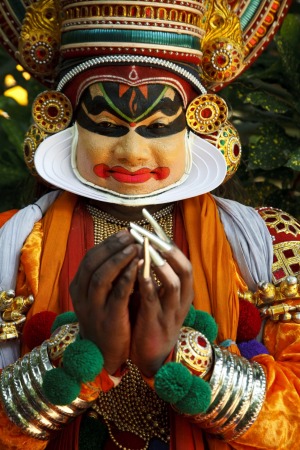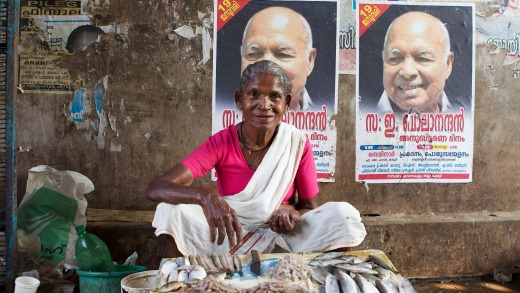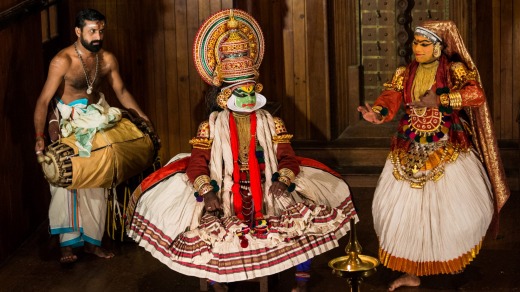
Our eyes meet across the darkened room. I smile, quietly pleased, that out of this room of strangers I've been singled out. Instinctively I lean forward, maintaining eye contact as he comes forward, a dashing figure in crimson and gold.
Without warning he stops mid-stride, bulges his eyes at me, quivers both brows in rapid-fire and throws back his head like a fairground-laughing clown.
In a blink my suitor has gone from Prince Charming to Jim Carrey in The Mask, complete with elastic lips and a lime green face. I burst out laughing.

This is my introduction to kathakali, the classical dance drama of Kerala, a blend of music and mime that has survived in this south-west state of India since the 17th century. Using symbolic makeup, billowing costumes, refined hand gestures and a raft of facial expressions, the dancers reenact stories from the Mahabharata and Ramayana.
Traditionally there were 101 classical kathakali stories, initially composed to last from sunset to dawn. Thankfully, I'm watching an abbreviated version at the Kerala Kathakali Centre in Fort Cochin, an arts school that aims to preserve and promote classical music, dance and martial arts.
In a blink my suitor has gone from Prince Charming to Jim Carrey in The Mask, complete with elastic lips and a lime green face.
With complete control of each individual facial muscle, a feat requiring at least 10 years tutorage, the performers produce nine facial expressions known as Nine Tastes or Navarasas. These cover everything from anger (knitted brow) and fear (eyes on stalks) to love (batted eyelashes) and disgust (wrinkled nose).

While the signals are cryptic (I can't decipher if I'm getting the come-on or the bugger off) the general theme is one of good prevailing over evil.
My Kermit-coloured suitor, Pacha, is the leading man in this supernatural soap opera, a god of noble character and exceptional taste in headwear. Made of wood and embellished with mirrors, colourful stones and pieces of shiny metal, his top-heavy three-tiered extravaganza is counterbalanced by layers of skirt, so opulent it weighs up to 30 kilograms.
Sitting in the darkened room, I'm soon swept up in a timeless tale of love and loss, each chapter told through mime, background song and accompanying drums. Through demons and demi-gods, fisticuffs and love tangles, the whole drama of human emotions is stripped bare, the dancers performing a ballet with every muscle of their face.

Before the performance we are invited to watch the cast applying their highly stylised makeup. "Colours and patterns are unique to each character," explains our guide Saravana Kumar. "It can take up to four hours to apply and another two hours to remove."
In silence, we stare transfixed as the leading man applies a thick base of green before adding black eyeliner and kewpie doll lips. With a tiny mirror in one hand and a fine bamboo taper in the other, he paints on elaborate markings to define his cheekbones, chin and lips.
Once that's completed, a second man applies the chutti, a series of handcrafted, three-dimensional ridges that further define the cheeks and jowl. "The aim is to transform a human being into a god," says Kumar.
Gods are everywhere in Kerala, in fact, the state is known as "God's own country", a moniker earned due to the state's wealth and prosperity, natural beauty and deeply religious nature, where Christianity and Islam rule as much as Hinduism.
A string-bean strip of green on India's southwest tip, Kerala stands in marked contrast to the rest of the country. It is immediately calmer and less chaotic than the northern states and we arrive from neighbouring Tamil Nadu to a steamy landscape of coconut plantations, rice paddies, Syrian Christian churches and elegant houseboats.
It is midway through our 14-day Spice of the South tour with Insider Journeys when we pull up at Fort Cochin in the old quarter of Kochi, the former spice port that put Kerala on the map as a trading post for Chinese, Arabian, Portuguese, Dutch and British merchants. Our base is the Brunton Boatyard Hotel, a harbourside hotel resurrected from the remains of a19th-century shipyard.
My heritage room, with views across the sea from both the bathtub and private balcony, has an air of old-money charm and colonial opulence: four-poster bed, crisp linen, fresh flowers and white wicker chairs.
I wake to the bleat of ships' horns, sounding their welcome and warning as they have done for centuries, plying their trade in everything from dug-out canoes and fishing boats to ferries and container ships. Finally, the previous evening's mystery gift of foam earplugs is solved.
On a morning walking tour, we visit the fishing nets along the seafront, giant pterodactyl-like contraptions that rise and plunge into the sea like a flock of hungry birds.
Introduced by the Chinese in 1350, the elaborate system of pulleys and ropes silhouetted against the setting sun is one of the most recognisable sights of Kerala.
"We call them cheena-vala," says our local guide, Vinay. "It is back-breaking work, and takes a team of five strong men to lift them."
Through Vinay's eyes I begin to see Kerala as the hard-working, deeply religious state that it is, rather than the glossy version depicted in postcards.
From the simple white sarong or mundu he wears knotted at his waist, to Malayalam, the local tongue-twisting language, Vinay explains how and why Kerala is different.
"As the first Indian state to come into contact with Christians and Muslims, we have developed a tolerant and textured culture," he says.
Amid the cry of fisherman heaving on ropes, or manhandling the counterweight rocks, we wander among the many and varied fishing stalls, where the booty from the morning's deep-sea fishing trip – snapper, salmon, tuna, prawns – can be bought fresh or cooked on site. A cluster of upturned plastic crates and a hand-painted sign, "You buy we cook" is Fort Cochin's equivalent to fast food.
Continuing on, we pass colonial-era homes, forts and churches built by the Portuguese, the Dutch and the British, their faded walls now peeling and covered by a mane of ivy.
St Francis Church is one of the best known, built in 1503 after the arrival of the great Portuguese explorer Vasco da Gama, it is the oldest European church in India.
Vinay gives us a quick history lesson – originally built from coconut tree trunks, renovated by the Dutch in 1779 and again by the British in 1805, changed from Catholic church to Protestant – but it's back on the streets, strolling under the mango trees and jackfruit trees, that we learn the most.
From an impromptu game of cricket with a gaggle of pint-sized Sachin Tendulkar hopefuls or uncovering a little-known art gallery tucked down a side street, to sipping tender coconut juice straight from the husk and chatting with poppadom sellers, it feels like I'm gathering a series of love letters or secrets.
Greedily, I grab these treasures, folding them into my heart for a future day when such uplifting memories will be needed.
From these ramshackle backstreets, Vinay leads us to the pungent spice bazaar, with its sacks of dried cardamom, cloves, cinnamon and pepper.
From here we pass Sunshine India (a "complete hassle free shop") the Crafty Palace ("government approved hassle free shop") the international pepper exchange (where pepper and spices are still traded once each month) and a sign for "God's own country", before reaching Paradesi Synagogue, the icon of Mattancherry or Jew Town.
While Fort Cochin has been home to a thriving Jewish community for the past 2000 years, sadly, today there are only eight Jewish individuals left. Vinay points out 90-year-old Sarah Cohen, sitting at the entrance to her embroidery shop and also the much younger Yaheh Hallegua, who collects the entrance fee at the Paradesi Synagogue, and is unlikely to ever marry.
Both women stare out from their lone posts with puzzled, almost mournful eyes, at a world that no longer has a place for them.
Later that night, at the Kerala Kathakali Centre, I watch the Jim Carrey lookalike switch from puzzled, to surprised, to fearful, to ecstatic, my own face mimicking his every action. But mostly I smile, a facial expression no one would have trouble interpreting. Happiness, as I'm finding, comes easy in God's own country.
1. Visit a tiger reserve in Nagarhole National Park in the state of Karnataka, with the chance of sighting tigers, wild elephants, leopards, deer and monkeys.
2. Take to the Kerala backwaters on a cruise aboard a traditional kettuvallam (rice barge) exploring the wildlife-rich network of lagoons, lakes and canals.
3. Board the Nilgiri Mountain Railway train in the state of Tamil Nadu. Also called the "toy train", because of its quaint blue and yellow carriages, this little engine travels between Mettupalayam and Ooty.
4. Learn about the tea industry in the Nilgiri Mountains in Tamil Nadu with a visit to the Doddabetta tea factory and plantation at Coonoor.
5. Uncover the beautifully preserved Hindu murals depicting scenes from the Ramayana and Mahabharata legends at the Mattancherry Palace. Also see the portrait gallery of maharajas from 1864 and a rare collection of hand-carried carriages.
MORE INFORMATION
insiderjourneys.com.au
GETTING THERE
Singapore Airlines operates regular flights from Sydney and Melbourne, via Singapore, to Bangalore and other departure points for Insider Journeys tours, see singaporeairlines.com. Australians need a visa for tourism for up to six months.
TOURING THERE
The 14-day Spice of the South Small Group Journeys run from September 2015 to March 2016. With a maximum of 16 passengers, the tour starts in Bangalore, and includes Mysore, Nagarhole National Park, Coonoor, Ooty, Munnar, and the Kerala backwaters before finishing in Cochin. Starting from $4675 per person twin share, excluding airfares. See insiderjourneys.com.au .